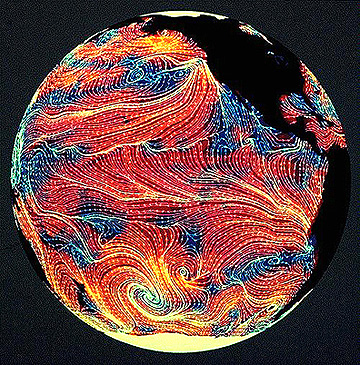
Seasat; Topex-Poseidon; NSCAT
Variations in temperature are major factors in the development,
strength, and directional behaviour of moving atmospheric gases,
or winds. Their prevailing motions change over time, but tend
to follow certain preferred paths in various parts of the world.
Determining wind directions must be done indirectly, by relating
them to the patterns of waves they produce, especially in the
open seas. This approach was used with data from the Scatterometer
on Seasat to generalize wind patterns over the Pacific Ocean:

Seasat was the first U.S. satellite that, as an original intention, was given as it primary mission the monitoring of oceanic surface phenomena, such as sea state (surface wave parameters, including wavelength, period, and height), surface wind fields, internal waves, currents and eddies, and sea ice characteristics. The microwave systems on Seasat were described in Section 8 (Harrisburg, Pennsylvania Radar Polarization). Radar images from Seasat over land surfaces proved so invaluable that the impression is gained that the marine applications have been subordinated. Nevertheless the system performed well as intended and much information about the oceans was gleaned during its 98 days of service in 1978 before an electrical short circuit disabled it.
Operating at a high depression angle (67 to 73°) to optimize detection
of waves, the L-band radar on Seasat (with its 25 meter resolution)
provided some exceptional images of ocean waves. We show an enlarged
image of the North Sea to illustrate this:
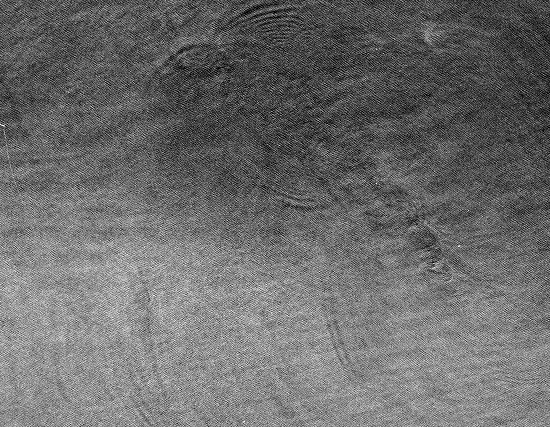
Assuming the display on your monitor favors details on careful
inspection, you should pick out a dominant set of numerous close-spaced
waves trending ENE arranged in patches that give a linear grain
to the image. There is a second well-developed NW set of similar
dimensions. Several clusters of large, curved, widely-spaced waves
may be internal waves.
Internal waves in shallow waters in the Gulf of California appear
in the Seasat image on the top below (north towards lower right).
Surface wave expressions related to variations in bathymetric
depths are evident in the Seasat image (north to upper left) on
the lower image showing the Nantucket Shoals off Rhode Island;
Nantucket Island is at bottom left.
The Topex-Poseidon mission, run by JPL, was also described in Section 8. W e suggest you access this outstanding Tutorial (http://topex.www.jpl.nasa.gov/education/ tutorial1.jpg) prepared by the T-P team which explores the kinds of information that are acquired by radar altimetry and scatterometry. (Comment: we judge this effort to be a model of what ought to be placed on the Internet by any of the satellite mission teams!)
Topex-Poseidon uses two radar altimeters to measure distance from the satellite to the sea's surface (to a precision of 4.3 cm). From such data, global maps can be derived that show Dynamic Ocean Topography (rises ["hills"] and depressions ["valleys"]), Sea Surface Variability, Wave Heights, and Wind Speeds. A separate microwave radiometer on T-P determines Precipitable Water Vapor which allows for corrections in the pulse transit time that improve distance accuracy.
The first T-P maps we will examine show ocean topographic variations.
Below is a plot of large-scale variations during September 1992
in ocean elevations relative to the Earth's geoid; the data used
to construct the map are modified from other sources such as gravitational
perturbations of satellite orbits. Note that as much as 150 meters
(487 feet) of "relief" exist on the seas between the Atlantic
Ocean (lower, green) and the western Pacific (higher, orange-red).
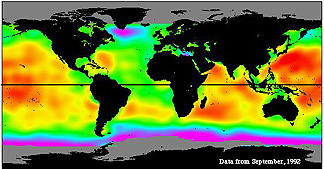
Seasonal differences do occur owing to departures from the norms in height as water expands or contracts in each hemisphere. The pair of maps below show Sea Surface Variation (SSV) in the northern Fall (upper) and Spring (lower), in a plot centered on the Pacific Ocean. The differences in elevation lead to redistribution of water through thermally-induced currents.
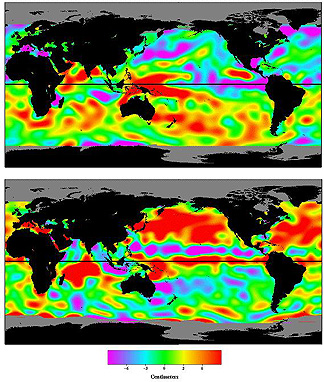
The next pair of maps are plots of wind speeds and wave heights
during June 1995. There is some correlation between these parameters:
greater speeds tend tp lead to higher waves.
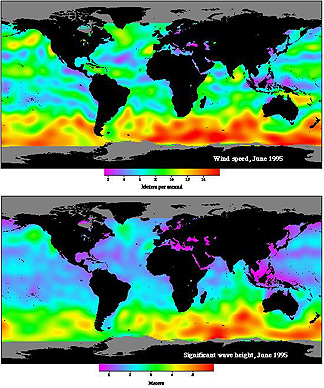
A follow-up to Topex-Poseidon, named JASON-1, is now scheduled for late 1999. It is a component of the EOS program discussed in Section 16.
The Jet Propulsion Laboratory (JPL) developed in cooperation with
Japan's NASDA a follow-on instrument to the Seasat Scatterometer,
called NSCAT (NASA Scatterometer). This was flown as part of the
multiple payloads on ADEOS, launched from Japan on August 16,
1996, that operated successfully for 9 months. The view below
shows the sophisticated nature of this satellite:
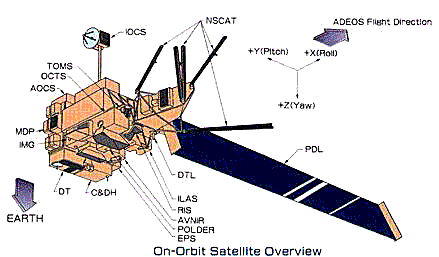
NSCAT was a microwave radar scatterometer that transmitted pulses at 13.995 GHz and measured their reflections (backscatter) from ocean ripples and other surfaces. Six antennas provided 8 beams that extended over two wide bands. The returned signal was subject to Doppler processing. Operating at 50 km spatial resolution, the system was capable of distinguishing and recording up to 268,000 wind vectors derived from wave-induced backscatter data.
The principal uses for NSCAT were in wind-direction determinations,
from which useful information relative to global climate patterns
could be derived. The instrument could also be operated over land
(Section 3-5) and produced sea-ice images (page 14-12). Here is
a global wind vector map, color coded for different velocities.
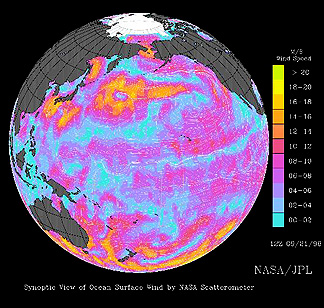
Code 935, Goddard Space Flight Center, NASA
Written by: Nicholas M. Short, Sr. email: nmshort@epix.net
and
Jon Robinson email: Jon.W.Robinson.1@gsfc.nasa.gov
Webmaster: Bill Dickinson Jr. email: rstwebmaster@gsti.com
Web Production: Christiane Robinson, Terri Ho and Nannette Fekete
Updated: 1999.03.15.